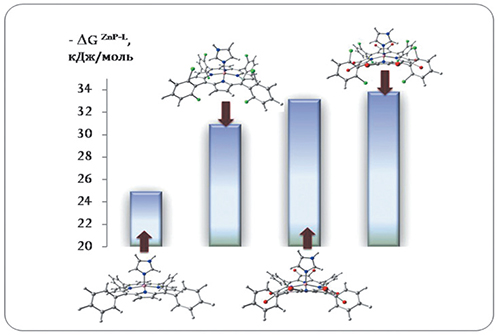Журнал "Макрогетероциклы"
Navigation
News
Impact Factor 2021 = 1.200 has been issued by ISI Web of Knowledge (JCR 2021).
Search
ISSN 1998-9539
The Effect of Selective Halogenation of Tetrapyrrolic Macrocycle on Binding Ability of Zn-Tetraarylporphyrins towards Small Organic Molecules
Processes of axial coordination of small organic molecules (imidazole, histidine, methyl ethers of p-aminobenzoic acid and valine) with Zn(II)-tetraarylporphyrins with different numbers of chlorine and bromine atoms in pyrrole and phenyl fragments of the macrocycle were studied by the methods of spectrophotometric titration and 1H NMR spectroscopy. Using quantum chemical calculations, the degree of distortion of the porphyrin macrocycle was determined as halogen atoms were consistently introduced into the macrocycle and the structures of the axial complexes of the studied zinc porphyrinates with ligands of various nature were optimized. The stability constants of the obtained complexes were calculated and a correspondence was found between the experimental, thermodynamic and calculated values of the Zn-L bond energy in the corresponding complexes.

| Attachment | Size |
|---|---|
| mhc191282m.pdf | 1.6 MB |
| mhc191282m_supp.pdf | 1.01 MB |
- 1088 reads
- Русский
